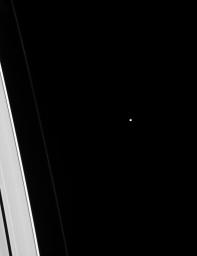Deceptively Small
Caption:
Tiny Epimetheus is dwarfed by adjacent slivers of the A and F rings. But is it really? Looks can be deceiving! There is approximately 10 to 20 times more mass in that tiny dot than in the piece of the A ring visible in this image!
In total, Saturn's rings have about as much mass as a few times the mass of the moon Mimas. (This mass estimate comes from measuring the waves raised in the rings by moons like Epimetheus.) The rings look physically larger than any moon because the individual ring particles are very small, giving them a large surface area for a given mass. Epimetheus (70 miles or 113 kilometers across), on the other hand, has a small surface area per mass compared to the rings, making it look deceptively small.
This view looks toward the sunlit side of the rings from about 19 degrees above the ringplane. The image was taken in visible light with the Cassini spacecraft narrow-angle camera on Dec. 5, 2014.
The view was obtained at a distance of approximately 1.2 million miles (2 million kilometers) from Epimetheus and at a Sun-Epimetheus-spacecraft, or phase, angle of 40 degrees. Image scale is 7 miles (12 kilometers) per pixel.
Background Info:
The Cassini-Huygens mission is a cooperative project of NASA, the European Space Agency and the Italian Space Agency. NASA's Jet Propulsion Laboratory, a division of the California Institute of Technology in Pasadena, manages the mission for NASA's Science Mission Directorate, Washington. The Cassini orbiter and its two onboard cameras were designed, developed and assembled at JPL. The imaging operations center is based at the Space Science Institute in Boulder, Colo.
For more information about the Cassini-Huygens mission visit
http://saturn.jpl.nasa.gov
and
http://www.nasa.gov/cassini
. The Cassini imaging team homepage is at
http://ciclops.org
.
Cataloging Keywords:
| Name |
Value |
Additional Values |
| Target |
Epimetheus |
A Ring, F Ring, Mimas, Saturn Rings |
| System |
Saturn |
|
| Target Type |
Satellite |
Ring |
| Mission |
Cassini-Huygens |
|
| Instrument Host |
Cassini Orbiter |
|
| Host Type |
Orbiter |
|
| Instrument |
Imaging Science Subsystem (ISS) |
|
| Detector |
Narrow Angle Camera |
|
| Extra Keywords |
Grayscale, Visual, Wave |
| Acquisition Date |
|
| Release Date |
2015-02-02 |
| Date in Caption |
2014-12-05 |
|
| Image Credit |
NASA/JPL-Caltech/Space Science Institute |
| Source |
photojournal.jpl.nasa.gov/catalog/PIA18302 |
| Identifier |
PIA18302 |

 Planetary Data System
Planetary Data System
